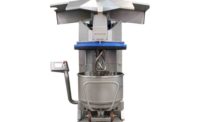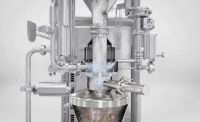New bakery mixers offer automation, sanitation, and continuous processing
Snack and bakery companies look for automation, ease of cleaning, and more in new and improved mixers.

Mixers serve essential functions for snack and bakery companies creating their own dough. We ask a lot of this category of heavy-duty equipment, including reliability and efficiency, to maintain established product quality-control standards.
Increasingly, we are asking more of this equipment than ever before. Automation, remote monitoring, continuous mixing, operator friendliness, ease of cleaning and sanitation, and the ability to quickly wash and hydrate ingredients are among the top desires of snack food and bakery companies in the market for new or improved mixers, according to mixer manufacturers.
AMF Bakery Systems - Dough Guardian, “hydro-bonding”
AMF Bakery Systems, Richmond, VA, hears most often about remote monitoring and easier sanitation, says Terry Bartsch, product group leader. “One of our driving goals is to reduce sanitation time,” he says, “and just the continued improvement in trying to make our equipment easy to clean.” The company also has prioritized “gathering information, putting it up into the cloud, and continuing to monitor and analyze the information.”
AMF has been optimizing its open-frame mixers using round, all stainless tubing so there’s no water retention, Bartsch says. The company also has been examining how its flour hydration process could be integrated with a batch-mixing system, partnering over the past 18 months or so with Reading Bakery Systems, Indianapolis, to lab-test the latter’s hydro-bonding technology.
“That hydrates flour on a micro level rather than dumping all the ingredients in the bowl and letting the agitator do the hydration,” he says. “It will immediately reduce the mix time, and that reduces dough temperatures and heat rise during the mixing process. We also have proved out that we can actually retain more water, anywhere between 3 percent and 5 percent.”
The company’s Dough Guardian system measures and tracks the energy generated by the motor once the product is in the mixer, which helps optimize parameters such as the length of the mix, Bartsch says. “It’s where we see that peak, is where the optimal input is,” he says. “We recently added a mix-to-energy feature, rather than just mixing-to-time, which had been traditional for horizontal mixers.”
AMF also has been furthering Dough Guardian’s development into a smart mixer by infusing the ability to analyze energy input on a continuous basis, Bartsch says. “We should be able to track and identify, ‘Do you need more water, or do you need more flour?’ Down the line for this product, that’s something we are evaluating, and looking at, and investigating, and working on. We’re building batch-mixing technology; not a lot is going to change inside the mixer. We’re looking at how we can optimize the systems around it.”
Bakery Concepts International - Rapidojet
Ken Schwenger, president of Bakery Concepts International, Enola, PA, says he’s been getting more and more questions about seed hydration and cleaning. “As the grains are sitting in the field, there are a lot of environmental stuff falling on them,” he says. “We’re eating all that stuff, pretty much. Bakers are relying on oven kill zones. When you use Rapidojet, when we’re hydrating them, we’re cleaning them, as well.”
Bakery Concepts has improved the scaling accuracy of the Rapidojet product, with a new calibration process for dry ingredients that uses a three-point system instead of two, Schwenger says. “Our new three-point calibration system ensures that our accuracy on dry [ingredients] is the same as a loss-and-weight system. When you combine that with our liquid accuracy, which gets within ½ of 1 percent, if you’re calling for 67 percent hydration, you’re going to get it. It’s a programing improvement to the two existing models of the machine.”
Bakery Concepts also has been studying how Rapidojet tackles the problem of “bucky” dough that’s less well-hydrated toward the end of a run than it was at the beginning, Schwenger says. “If you’re a big bakery, and you’re mixing 1,000 pounds, 2,000 pounds, 3,000 pounds of product, and you dump that into a trough, into the front of a makeup line, the first 10 pounds of product that runs down that line is going to be markedly different than the last 10 pounds.”
Metal mixing tools that force wet and dry ingredients together don’t mesh them as well, Schwenger says. “Every flour particle and everything else that you’re trying to hydrate, or mix, has a natural surface tension barrier to liquids,” he says. “It takes a while for all the liquids, including the water, to penetrate every molecule of drys. The beauty of Rapidojet, with its patented high pressure, is that is instantaneously achieves the proper hydration level.”
Charles Ross & Son Company - ROSS Ribbon Blenders, Optional Pressure Feed Vessel
Christine Banaszek, an application engineer & sales manager at Charles Ross & Son Company, Hauppauge, NY, says her customers are seeking features that enhance operator-friendliness and ease of cleaning. Custom safety gratings, bulk bag unloading stations, pneumatic valves, sanitary fittings, CIP spray nozzles, and other options are available to solve these challenges on the company’s mixers, she says.
Charles Ross & Son Company has added an optional pressure feed vessel to its ROSS Ribbon Blenders, Banaszek says. “Wherein minor liquid ingredients must be thoroughly blended into powder or other solids, a pressure feed vessel enables 100 percent discharge of the liquid component through a spray bar and into the blending zone, ensuring even mixing and consistent batches,” she says.
Instead of manually pouring liquids through an open blender cover or safety grating, customers can use a pressure feed vessel and spray bar, which facilitates liquid addition while the blender is closer, minimizing dusting and safety issues, Banaszek says. “The spray bar typically includes four or more spray nozzles so that liquids are uniformly distributed along the entire length of the blender,” she says. “The pressure feed vessel eliminates the need for a pump to deliver liquids to the spray bar.”
After the blending cycle, the pressure feed vessel also can help with cleaning-in-place and washdown, Banaszek adds. “Available in various sizes to accommodate the required volume of the additive liquid phase, these vessels are mounted and plumbed to ROSS Ribbon Blenders, which range from ½ to 500 cubic foot working capacity,” she says.
Shaffer Manufacturing - Over-Tilt & High-Capacity Mixers
Shaffer Manufacturing, Urbana, Ohio, which is now a subsidiary of the French company LINXIS Group, also hears from customers who want to automate and simplify their processes so they need fewer people, says Andrew McGhie, director of sales. “Sanitation is related to that as well—they want to be able to clean the mixers easily with minimal intervention by the operators because they don’t have the people,” he says.
Ideally, they want high-pressure cleaning-in-place to ensure that allergens are properly cleaned as quickly as possible for gluten-free formulations, McGhie says. Customers also are looking to collect and share data to monitoring machinery processes, he says, and they would like mixers to come with high-efficiency motors that use less electricity, save money and are more environmentally friendly—which Shaffer, in turn, has been asking of its vendors for these parts.
Shaffer has been working regularly with customers to more thoroughly automate their existing equipment, McGhie says. “We need to be able to dump the dough out, automatically, without anybody touching it, into the chunker, the dough pump, or wherever it’s going next,” he says.
Where standard mixers have about a 120-degree tilt, Shaffer has been moving toward 160- or even 180-degree “over-tilt” designs so that the dough discharges automatically, even if it’s sticky, McGhie says. The company also has been automating its machines on the ingredient handling side so that the next batch starts when the current one ends. “The last two years, that’s become huge because people are so hard to get and hold onto,” he says.
Customers also have been asking Shaffer for higher-capacity bagel mixers, which presents a challenge given that bagel dough is particularly stiff, with low water absorption, and thus generates quite a bit of torque inside the mixer, McGhie says. “It’s like mixing concrete,” he says. “Because of the torque and high horsepower required, the structural columns, the tubular stainless steel bowl ends and agitator ends all have to be thicker and stronger.”
In the past, the company hadn’t gone much beyond 2,000-pound machines, and even those customers didn’t typically try to handle more than 1,300 pounds of dough at once. But Shaffer is now handling mixers that can handle up to 2,800 pounds of bagel dough, and customers are exceeding 2,000 pounds in their runs, McGhie says. “We previously had stepped away from projects like that and said, ‘You don’t want to do that; you should have two smaller mixers,’ ” he says. “But customers kept pushing us.”
Zeppelin Systems - CODOS NT, DymoMix
Customers of Zeppelin Systems, Odessa, FL, continuously request continuous mixing, says Stephen Marquardt, vice president, sales and marketing. “They can’t afford to have 30, 40, 50 people on the floor,” he says. “It’s not an easy situation right now that we all live in; we have the same problem on the plant-engineering stuff. What is the easiest and most efficient way to help plant owners ensure that their operation is running smoother?”
Automated ingredient handling is another common desire of Zeppelin Systems customers, Marquardt says. “Not only for bulk ingredients but also for micro-ingredients, to ensure you have the proper mix,” he says. “A lot of people still do this by hand.” But with the “great resignation,” such labor is harder to come by. “Who wants to work the night shift?” he adds. “That’s the big problem. System providers like us have to put our heads together and say, ‘How can we make our lines more efficient?’ ”
Zeppelin Systems has upgraded its CODOS continuous mixer into the new CODOS NT, which stands for New Technology and refers to the new model’s automated controls, more advanced cooling system, additional motors and greater efficiency, Marquardt says. When combined with the company’s DymoMix prehydration system, CODOS then handles the final kneading and mixing; it’s no longer necessary as a blender except for certain products like tortillas that produce a lot of return dough that needs to be reincorporated into the mixer, he says.
“What’s really revolutionary with the CODOS DymoMix combination is with starches that are gluten-free products, you have a great pre-hydration,” Marquardt says. “It’s so good for that lump-free process. … Gluten-free products have a tendency, with these fine powders, to take water, suck it in, and that’s it. With the combination of DymoMix hydrating ingredients on the micro-particle level, they’re absolutely lump-free due to instant biochemical processes.”
Large bakeries appreciate this process because it processed higher yields with lower fermentation and yeast contents, as well as reduced energy costs, he says. “We believe continuous mixing is the future,” he adds. “Bakeries have huge problems with maintaining operations of the systems because of lack of staff. They have to think more efficiently.”
Looking for a reprint of this article?
From high-res PDFs to custom plaques, order your copy today!






